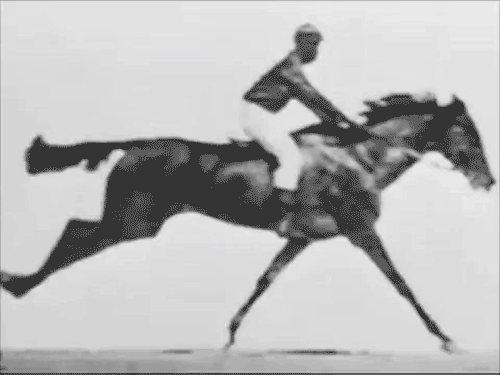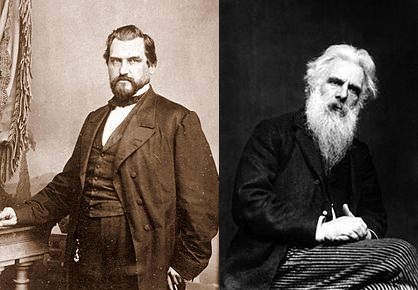You’ve probably seen this archaic image of equine locomotion floating about the internet at some point or another:

via Tumblr
What you might not know is that this galloping horse gif is a groundbreaking piece of motion picture. Created by photographer Eadweard Muybridge in 1878, it is the first animated image sequenced photograph ever created…and as the legend goes, it was made to settle a bet.
Yes, this pioneering photographic achievement was spurred not in the name of arts and sciences, but rather, gambling.
It all began with a wealthy 19th century industry tycoon and horse hobbyist named Leland Stanford. It was June of 1878, and a parade of fellow horsemen and curious reporters were gathered at Stanford’s sprawling Palo Alto Stock Farm in Northern California, where he bred and trained Thoroughbred and Standardbred racehorses. They had been invited by Stanford himself to watch one of his horses gallop around the track.

Leland Stanford (left) and Eadweard Muybridge, gentleman, scholar, inventor, avenger. (wikipedia commons)
This was more than a hifalutin meet-n-greet, however. This was history. See, there was a raging debate at the time, both among horsemen and the general public, involving the gait of a galloping horse. Some, like Stanford, believed in “unsupported transit”, or to put it plainly, that during the gallop the horse has all four hooves are in the air simultaneously.
While today we all know this to be fact, at the time the technology simply did not exist to back up such a bold claim. So it was, the majority fell under the opinion that a horse must have at least one foot on the ground at all times to support locomotion.
So Stanford set out to prove his theory. He needed a way to capture the very moment, undetectable to the naked eye, when a galloping horse goes completely airborne. He needed a photograph. Which led him to Eadweard Muybridge.
The grand reveal on that summer day in 1878 was the culmination of an exhaustive, five year collaboration between Stanford and Muybridge. Stanford had the resources and Muybridge the acumen, and together they worked towards finding a way to capture each and every aspect of a horse’s gait.
Here’s what they ultimately came up with:
24 state-of-the-art cameras set-up 27 inches apart along the side of the racetrack. They rigged up each camera with chest-high trip wires, so that when the horse passed through she would trigger each shutter. The horse chosen for the experiment was Stanford’s prized Kentucky-bred mare Sallie Gardner, ridden by a jockey known only by the name G. Domm, was put into full gallop and wouldn’t you know it, it all went off without a hitch.
For the first time in history, humans could now see every aspect of a moving horse, including the split-second when all four feet are simultaneously off the ground. The photos were then spliced together to create the world’s first true motion picture, “Sallie Gardner at a Gallop”. It was a victory for science, art and Stanford, who as legend has it, had $25,000 riding on his bold belief.
THE WORLD IS ROUND AND HORSES CAN FLY!

Muybridge’s The Horse in Motion, 1878 (Library of Congress)
In an era obsessed with technological innovation, the project vaulted Muybridge into the mainstream, among such names as Edison, Tesla and Nobel. It was quite the ascension for a brilliant but “peculiar” man who, a decade before meeting Stanford, went on trial for shooting and killing his wife’s lover, Major Harry Larkyns. The trial was front page news across the nation and Muybridge was eventually acquitted of all charges on the grounds that it was justifiable homicide (some historians claim his unpredictable behavior can be attributed to a head injury suffered in a stagecoach accident in 1860).
With all that behind him and with this groundbreaking discovery under his belt, Muybridge continued his focus on film, with animals as his primary subject.

Muybridge’s Cat Galloping, 1878 (Library of Congress)

Muybridge Man and Horse Jumping, 1878 (Library of Congress)
As for Stanford, well, he eventually donated a large portion of his Palo Alto land, as well as his name and established an institution of higher learning: Stanford University.
And that’s how two men, a wager and a racehorse revolutionized photography and paved the way for the modern motion picture.
We love you, history. Never change.
Still curious? Cool, let’s get weird…




 March 15, 2016
March 15, 2016 






















